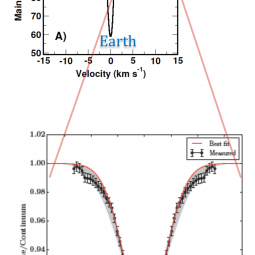Atomic oxygen is a key component in regulation of energy and mass exchanges within the Martian atmosphere. Neutral atomic oxygen (O I) was detected in the Martian atmosphere at a frequency of 4.7 THz (63 μm) on 14 May 2014 using the high-frequency channel of the far-infrared heterodyne spectrometer GREAT (German Receiver for Astronomy at Terahertz Frequencies; P.I. Rolf Güsten, Max Planck Institut für Radioastronomie) onboard SOFIA. The [O I] line was found in absorption against the Mars continuum with a high signal-to-noise ratio (see figures).
The abundance of atomic oxygen in the Martian atmosphere is notoriously difficult to measure. Prior to the SOFIA detection, such measurements had not been made since the Viking and Mariner missions in the 1970s. The SOFIA/GREAT detection is the first direct measurements of the atomic oxygen content of the Martian mesosphere, 70-120 km above the planet’s surface.
This measurement was made possible through the unique stratospheric platform offered by SOFIA as well as by technological advances in terahertz detectors implemented in the GREAT instrument. SOFIA’s 2.5-meter telescope aperture offers relatively high far-infrared spatial resolution (diffraction beam width θ ~ 6 arcsec at 63 μm). The very high spectral resolving power of the GREAT instrument (R ~ 108 after data processing) allowed the Martian [O I] line to be distinguished easily from the telluric line by their relative Doppler shifts.
Atomic oxygen plays an important role in the physics of planetary atmospheres, including that of Earth, by controlling the thermal balance that in turn influences rates of escape of other gases. The observed intensity of the [O I] line implies an atomic oxygen abundance that is about half the value predicted by a modern global circulation and photochemical model of the Martian atmosphere (Forget et al. 1999, J. Geophys. Res. 104, 24155). The factor of two discrepancy between measured and predicted Mars atomic oxygen abundance may be due to inaccuracy of the model, or to temporal and spatial variations of Martian atmospheric chemistry.
The variability of atomic oxygen content in the Martian atmosphere as a function of latitude, local solar time, and season can now be measured via continued SOFIA observations of the far-infrared 63 μm [O I] line. Such observations will provide planetary science researchers with improved information regarding the energetics and dynamics of the Martian atmosphere.
More detailed information is in Rezac et al. 2015 , Astronomy & Astrophysics 580, L10.
The SOFIA program is a partnership of NASA and DLR. NASA's Ames Research Center located in Moffett Field, California manages the overall SOFIA mission in cooperation with Universities Space Research Association (USRA), located in Columbia, Maryland, and the Deutsches SOFIA Institut (DSI), located in Stuttgart, Germany. The SOFIA aircraft is based at the NASA Armstrong Flight Research Center Building 703 operations facility in Palmdale, California.
![SOFIA/GREAT [O I] spectrum at 4.7 THz (63 μm) superimposed on a picture of Mars. SOFIA/GREAT [O I] spectrum at 4.7 THz (63 μm) superimposed on a picture of Mars.](/data/SOFIA/docs/sites/default/files/styles/gallery_thumb/public/MarsGREAT.jpg)
